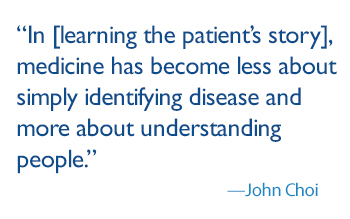Want to read more from the Johns Hopkins School of Medicine? Subscribe to the Biomedical Odyssey blog and receive new posts directly in your inbox.
(Disclaimers: Although much of the following comes from my medical education, it should not be generalized to all medical students. Certain details — name, identifiers, complaints — have been modified for privacy reasons.)
7:59 p.m. I am standing outside the patient’s room in the hospital. She has just been transferred from the emergency department (ED).
In my hand, I have a few pieces of information. The patient’s name is Ms. Terry. She is 62 years old, and she was admitted earlier this morning for cough and chest pain. Earlier, I checked our electronic medical record to see if she had any documents on file. Often times, having access to such information can help guide questioning. In this case, though, there are no such records.
Taking a deep breath, I knock — twice — and open the door slowly. In about two seconds, I assess the situation. Is the patient sleeping? Is she moaning in pain or is she energetically talking on the phone? In this case, the television is on and Ms. Terry looks over to me with a questioning smile. She is sitting upright in bed with the blanket neatly draped around her. I smile and match my tone to her presentation, emitting a soft but steady greeting.
“Hello, my name is John Choi. I’ll be your medical student during your stay here.”
Sanitizing my hands first, I walk over and shake her hand. She has a strong grip. When I release her hand, though, it takes more than a few seconds to pink back up. I also notice slight clubbing in her nails. My mind reflexively jumps to possible circulation issues and chronic hypoxia (a lack of oxygen in the tissues). I take mental note of my preliminary findings and file them for later.
As part of my introduction, I explain what I will be doing — namely, taking a history and doing a physical exam — and describe what she might expect during her hospitalization. Throughout all this, I continue to observe her, trying to bring together some of the pieces of the puzzles. I note that she is breathing fairly rapidly. I try breathing at the same rate as her and find myself getting short of breath. This is not a good sign. Also, at a certain angle, I notice an elevated biphasic wave pattern on the side of her neck — a probable sign of excess fluid in her system. But again, I place these observations at the back of my mind and instead pull up a chair to the side of her bed. Sitting down, I start by asking her if she could share what brought her to the hospital. In my mind, though, I ask: Can you tell me your story?
I encourage the patient to speak without interrupting her. She tells me that she experienced severe chest pain a few days ago. With just this one complaint, a flurry of worrisome diagnoses flashes into my mind: myocardial infarction, aortic dissection, acute pericarditis, pulmonary embolism, pneumothorax, gastric reflux, esophagitis, etc. She notes an ongoing cough that began a few days prior to the chest pain, and that she has found it increasingly hard to breathe while lying down. A few minutes in, it is easy to jump to one or two diagnoses, but instead I force myself to pause and think: What else can this be?
In Jerome Groopman’s book How Doctors Think, the author explains that one of the most important questions physicians can ask themselves is, “What else can this be?” Forcing ourselves to ask this question prevents us from falling back on the most obvious diagnosis without carefully considering other options. In this case, I resist the urge to ask questions to confirm what might be the most obvious diagnosis and instead continue to let Ms. Terry talk. And she does.
She tells me about her family. She goes into some past hospital visits. She walks me through her allergies and medications with a certain meticulousness that matches her politeness. She tells me about her past drug use and vehemently denies smoking or drinking alcohol. She talks about her hobbies and glows when she mentions her fiancée and home — it is obvious that she already misses both. Slowly but surely, Ms. Terry’s story comes to light. The story is then augmented as I begin the physical exam to methodologically observe and examine different organ systems.
 Through this careful process of history taking and physical examination, I generate a hypothesis as to what is most likely going on. The patient is diagnosed with pneumonia and pre-existing heart failure. I take a step back and retell the story with my medical reasoning, asking if this version makes sense. Afterwards, as sort of an appendix, I think about which labs would be needed to rule out or confirm these diagnoses. Once a probable diagnosis is made, treatment and management begins.
Through this careful process of history taking and physical examination, I generate a hypothesis as to what is most likely going on. The patient is diagnosed with pneumonia and pre-existing heart failure. I take a step back and retell the story with my medical reasoning, asking if this version makes sense. Afterwards, as sort of an appendix, I think about which labs would be needed to rule out or confirm these diagnoses. Once a probable diagnosis is made, treatment and management begins.
It is necessary to emphasize that paramount to this entire process is the process of learning the patient’s story — both through their words and through the findings on their physical exam. In doing so, medicine has become less about simply identifying disease and more about understanding people. In the words of Sir William Osler, “It is much more important to know what sort of a patient has a disease than what sort of a disease a patient has.”

I would like your students to evaluate the events and accurrences that happened to my Mom during her stay at two different Nursing Facilities? Twitter: @ronald_terrell
Comments are closed.